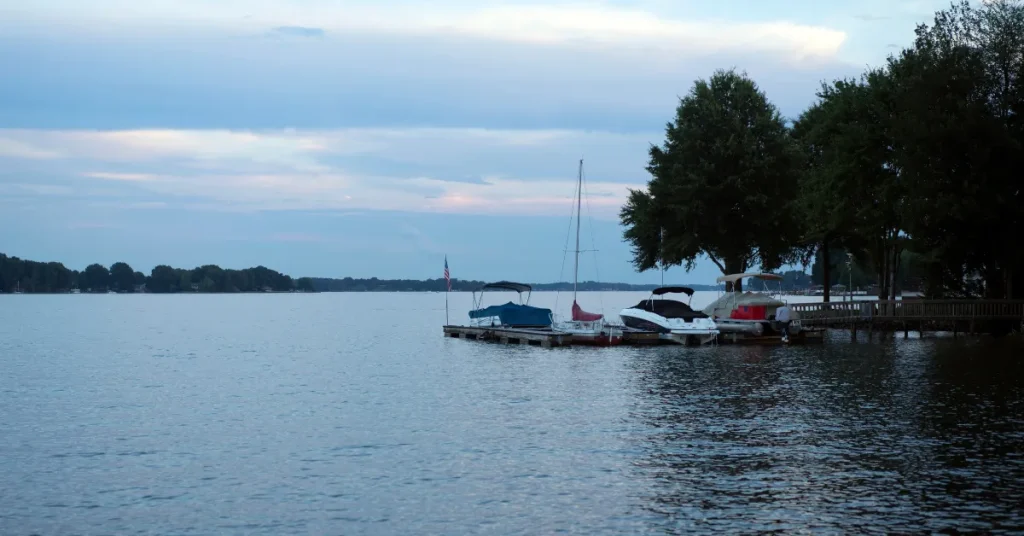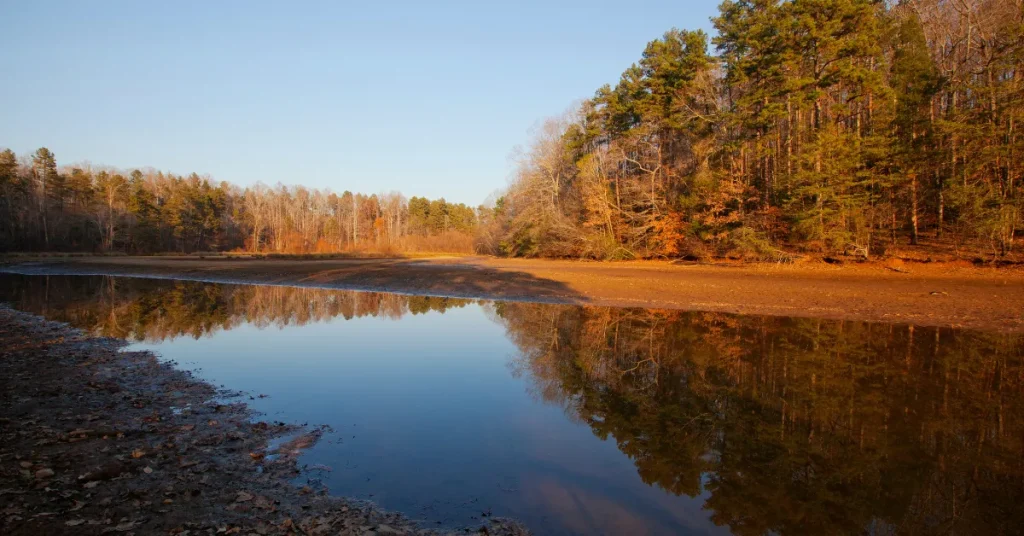Lake Norman has a maximum depth of approximately 130 feet. The average depth of this manmade lake is around 33.5 feet.
Nestled in North Carolina, Lake Norman boasts a reputation as the largest man-made body of fresh water in the state. Created in the early 1960s, this sprawling aquatic haven serves as a hub for recreation, boasting activities such as fishing, boating, and water sports.
Its vast surface area of about 50 square miles provides a scenic retreat for residents and tourists alike. The lake’s extensive shoreline is dotted with picturesque homes, parks, and marinas, making it a favored destination for weekend getaways and outdoor adventures.
Lake Norman’s accessibility from nearby Charlotte further enhances its appeal as a convenient escape for those seeking a balance of leisure and natural beauty.

Plunging Into Lake Norman’s Depths
Curiosity often drives us to explore the mysteries hidden beneath the waters of Lake Norman. With visitors and locals alike marveling at its vastness, understanding the true depths of this man-made wonder proves to be a fascinating journey.
The Creation Of An Inland Sea
Lake Norman’s birth is a tale of human engineering. In the 1960s, Duke Energy transformed the area with the Cowans Ford Dam. This bold act created the largest freshwater oasis in North Carolina. Here’s a brief sneak peek into its creation:
- 1963: Waters rise, submerging miles of rich terrain.
- Nature reshaped: A vast expanse of water spans where forests once stood.
- Local ecosystem: Flora and fauna adapt, calling this inland sea their home.
Measuring The Mysterious Depths
How deep does Lake Norman go? Let’s plunge into the numbers:
| Area | Approximate Depth |
| Near Cowans Ford Dam | 130 feet |
| Mid-lake areas | 60-90 feet |
| Shoreline edges | 10-20 feet |
These depths are not just numbers. They speak to the lake’s rich biodiversity and serve as a guide for the adventurous divers and fishers seeking a bountiful catch or a glimpse into the unseen.
Lake Norman’s Place In North Carolina

Nestled in the heart of North Carolina, Lake Norman stands as a sparkling jewel among the state’s various bodies of water.
Often referred to as the “inland sea,” this vast reservoir stretches across four counties. With its impressive size, Lake Norman holds the title as the largest man-made body of fresh water within the state.
Formed by the damming of the Catawba River, its creation was not merely by chance but by design. Complementing the beauty of the rolling hills that embrace its shores, Lake Norman plays a pivotal role in providing power, water, and endless recreation to the Tar Heel state.
A Geographic Masterpiece
Lake Norman’s vastness creates a breathtaking panorama that captures the essence of the region’s geography. With 520 miles of shoreline meandering through a lush landscape, it mirrors the sky on a surface area of 32,475 acres.
Depths here plunge dramatically, with the deepest point reaching approximately 130 feet. The lake’s shoreline hosts various ecosystems, each contributing to the lake’s geographic significance and diverse wildlife habitat.
Recreational Haven Meets Natural Resource
Beyond its environmental impacts, Lake Norman serves as a year-round recreational paradise. Here, residents and visitors alike engage in a multitude of activities:
- Boating and Sailing
- Swimming and Water Sports
- Fishing for bass, catfish, and crappie
- Exploring quaint lakeside towns
Its role extends beyond leisure; Lake Norman is also a crucial natural resource. It facilitates the smooth operation of the Cowans Ford Dam, powering countless homes and businesses.
This careful balance of fun and functionality cements Lake Norman’s place as a treasured North Carolina landmark.
The Ecosystem Beneath The Surface
Dive into the Ecosystem Beneath the Surface of Lake Norman, where a hidden aquatic world thrives.
This remarkable ecosystem, shadowed by the lake’s tranquil waters, houses a rich array of habitats and wildlife. As we explore these underwater sanctuaries, we unlock secrets of the deep that support a vibrant, living community.
Habitats In The Deep
Lake Norman’s depths create diverse habitats, each vital to the lake’s overall health. From rocky outcrops to silty bottoms, these underwater terrains offer homes and hunting grounds for numerous species.
- Rocky Reefs: Shelters for small fish and crustaceans.
- Vegetated Areas: Nursery zones for juvenile wildlife.
- Open Water: Feeding grounds for larger fish.
- Sediment Beds: Hosting bottom dwellers and microorganisms.
Wildlife Of The Watery Realm
The real stars of Lake Norman are its residents. These inhabitants range from agile fish to slow-moving mollusks, forming a web of life.
| Species | Role | Habitat |
| Largemouth Bass | Predator | Rocky & Vegetated Areas |
| Catfish | Scavenger | Sediment Beds |
| Freshwater Mussels | Filter Feeders | Muddy Bottoms |
| Turtles | Herbivores/Omnivores | Along the Shoreline |
Each species contributes to a balanced underwater community. With careful observation, understanding blooms for the roles these creatures play beneath the waves.
Human Interactions With The Lake’s Depths
Human Interactions with Lake Norman’s Depths hold stories and activities that go beyond just the surface. This lake, with its varying depth, invites people to explore, fish, and connect with the past in unique ways.
Diving Into History
Lake Norman’s history is etched deep beneath its waters. Once home to entire communities, folks dive here to witness submerged remnants of a bygone era. They find old bridges, building foundations, and even roadbeds that once connected people, now linking them to history.
Fishing And The Depth Factor
The depth of Lake Norman greatly influences the lake’s fishing dynamics. Anglers know that different species prefer specific depths depending on the season.
- Bass prosper in shallower regions during spring.
- Catfish and stripers, on the other hand, roam deeper waters.
Knowledge of depth enables fishers to target spots with optimized success.
Environmental Concerns And Conservation

Lake Norman’s beauty goes much deeper than its surface. Yet beneath the waves, issues like pollution and habitat disruption loom large. Ensuring the longevity and health of this sprawling aquatic wonder hinges on addressing these environmental concerns head-on.
Protecting The Lake’s Depths
Even the deepest points of Lake Norman need safeguarding. Local conservation groups and residents collaborate to monitor water quality. They organize clean-ups to reduce debris and pollutants that threaten the lake’s ecosystem.
- Bold initiatives drive community involvement
- Educational programs raise awareness about pollution
- Regulations help to minimize environmental impact
Protecting native wildlife is paramount. This includes fish species, birds, and plant life that rely on the lake’s unique habitat. Sustainable fishing practices and habitat restoration projects play a critical role.
Future Challenges For Lake Norman
Climate change and population growth present ongoing hurdles for Lake Norman. Warmer temperatures can lead to harmful algal blooms, affecting water quality and aquatic life.
Development along the shores puts pressure on the natural landscape. It calls for strict zoning laws and responsible construction practices. Ensuring these measures can safeguard Lake Norman’s depths for generations to come.
| Action | Impact |
| Community Clean-Up Drives | Reduce Pollution |
| Wildlife Conservation Programs | Protect Biodiversity |
| Eco-Friendly Zoning Regulations | Control Shoreline Development |
FAQs About How Deep Is Lake Norman
How Deep Is Lake Norman At Its Deepest Point?
Lake Norman’s deepest point measures approximately 110 feet. This depth is found in a smaller section of the lake known colloquially as “The Abyss. “
What Is The Average Depth Of Lake Norman?
On average, Lake Norman has a depth of about 33. 5 feet. However, this can vary greatly across different areas of the lake.
Where Is Lake Norman Located?
Lake Norman lies in North Carolina and is the largest man-made body of fresh water in the state. It is situated about 20 miles north of Charlotte.
How Was Lake Norman Created?
Lake Norman was created between 1959 and 1964 with the construction of the Cowans Ford Dam on the Catawba River, for hydroelectric power.
Conclusion
Exploring the depths of Lake Norman reveals a fascinating underwater world teeming with diversity. Whether you’re a seasoned angler or simply seeking a serene escape, understanding this lake’s vastness enriches your experience.
Dive into its history and aquatic life, and let Lake Norman’s mysteries captivate your imagination.
Resources:
1. https://www.ncparks.gov/state-parks/lake-norman-state-park
